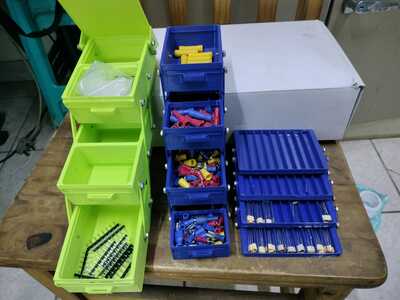Hello from South Africa.
I'm a newby to the exciting world of electronics. Being a retired professional mechanical engineer, I'm obviously way over my head but with the help of so many people like Bill and others there is an endless knowledge base to tap from. Being a neatness freak I'm struggling to find suitable ways to store the myriad of electronic components and gadgets in my workspace. I currently make use of plastic ziplock bags to store things like jumper cables (the prefabricated types with Du Pont connectors), resistors, etc. Any suggestions?
Hi Lourens, and welcome to the forum. I'm new to this too and I feel your pain. I use a little plastic drawer cabinet for stuff that I use all the time, like resistors and jumper leads. You can get a hell of a lot of resistors in a small drawer, but they have to be big enough to get your fingers in. I also like to buy components like transistors and capacitors in selection boxes. You can get a whole range of values in one go and the boxes stack nicely on a shelf. Whichever way you do it, you end up storing a lot more air than components. Good luck.
Part of the problem with getting advice on this is that people operate at very different scales when it comes to electronic component selections.
Personally, I have 6 distinct places where electronic components are stored around my workbench.
- To one side of where I sit, there is a low 1 sq ft cube with 2 PLANO stor-aways, and a tall, thin tackle box (they were an auction find). The tacklebox contains all of my sorted resistors, grouped around similarish resistance, as often I'm just looking for something "a few k". The top section of the tacklebox contains a few selection boxes with capacitors, inductors, and LEDs. The stor-aways contain a pile of switches, ports, push buttons, connectors (such as USB ports mounted on very small PCBs), wagos, etc.
- Above that is a 18" wide x 14" deep x 5" high cubby that contains all of my breadboards and all of my breadboard wiring, as well as quite a bit of other random bits of wire with connectors already attached.
- My benchtop itself is limited to tools, power-supplies, solder, and a "random bits I haven't sorted yet" bin (which is intentionally kept rather small), this includes a kitchen utensil carousel that contains _most_ of my electrical tools such as flush cutters, crimpers, calipers, etc. I don't have convenient wall storage, where I am.
- To my left, I have one drawer of a cheap plastic drawer storage tower full of "things too large to go elsewhere". This is stuff like a spare multimeter, a 24V step-up converter module, packaged projects I haven't started yet, and things like Kapton tape (rarely used, as well as large and inconvenient to put on the benchtop)
- A "drawer" which is actually a delivery box from an apple laptop. Long, fairly wide, and shallow, it's basically a holder for a mess of those selection boxes Mike was talking about, placed on their sides so I can pack them in. This is where connectors go, as well as a few small screw-sets, and I have a few repurposed selection boxes there and now they're used for things like "power converters", relays, CD4000-series ICs. This also contains a box with prototyping boards and a few odds and ends such as a set of motor controllers.
- "the junkyard" is a bookshelf rescue from the side of the road. It sits in the corner of my office and contains boxes containing motors, batteries and circuit boards rescued out of various pieces of junk that have been thrown away. It contains the innards of toys, ATX power supplies, a dishwasher control module, 90% of the electronics of a high-end treadmill (and the ridiculously beefy motor... bottom shelf for that one), and a few other things.
One thing I highly recommend as you start buying small components... make a list. Whenever I buy something that will go into a circuit, I find it helpful to add it to a google sheets list. I track "part number", "qty", "footprint" "source", and data sheet if there's a link. I do this for all circuit components like resistors, capacitors, ICs, BJTs, mosfets... as well as integrated boards that could be added to a circuit (such as the various power converters and drivers). The slightly weird tab on my spreadsheet is the "sensors" tab.
Contrary to how some people approach this, I do not "keep inventory", I merely observe when I'm running low on something and add something to a long-running shopping cart as I take it out of the box. But the list is useful when deciding if I have a component, or need to swap in for a replacement.
Effectively, when I'm hunting for a part to fix something, I go to the spreadsheet first, then I go to "the junkyard" if it's something likely to be there (like a large value capacitor off a random power board), and then off to order the part.
"A resistor makes a lightbulb and a capacitor makes an explosion when connected wrong"
"There are two types of electrical engineers, those intentionally making antennas and those accidentally doing so."
@mike-parsons Good day Miike I'm from South Africa as well. (JHB) I have purchased a 3D printer and there are a huge variety of storage boxes on Thingiverse. It works great for all the stuff. Neatly marked and on hand when you need it, and wont take up much space. Not sure if there is a printing supplier near you who you can ask to print for you.

